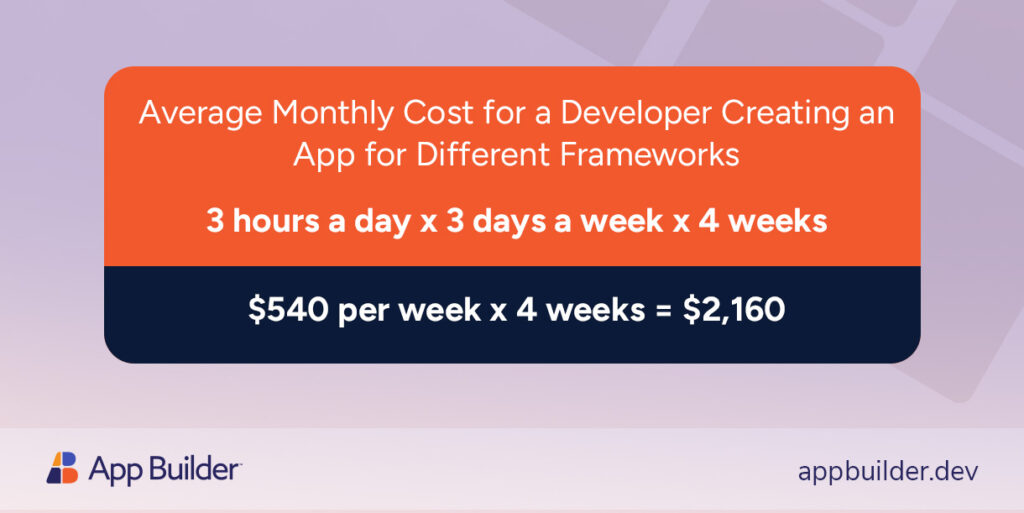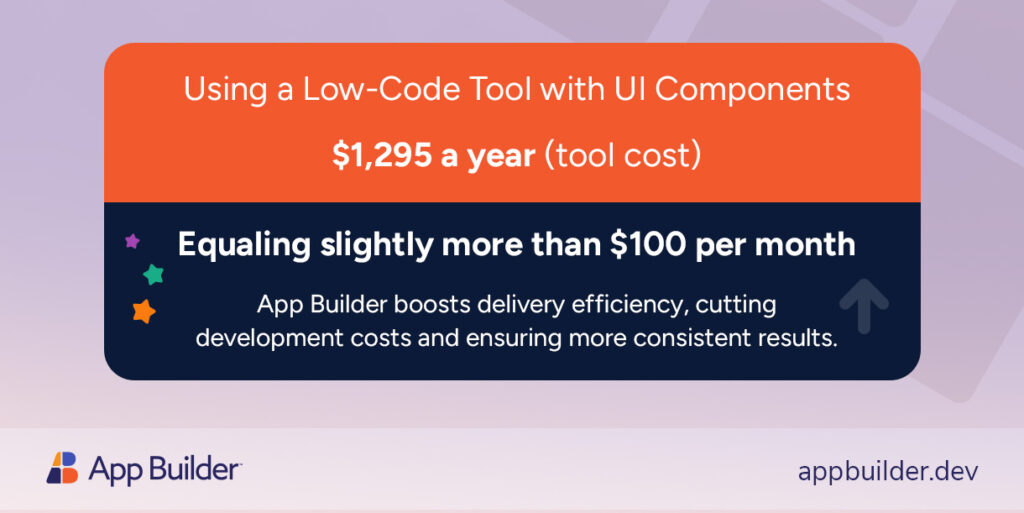
How To Reduce App Development Costs With Low-Code Tools?
In challenging times when reducing development costs and achieving optimization are a must, tools like App Builder can achieve cost-efficiency, streamlining the software development life cycle, delivering proven ROI, and helping companies adapt to the dynamic software development environment.
Today’s software market is dynamic, with the demand for custom solutions outpacing supply and driving up app development costs. To cope with this, companies have shifted energy to establish new business models and software development processes, aiming at order-of-magnitude reductions in IT expenses and project overhead.
But it doesn’t strictly mean cutting back on budgets only.
In these challenging times for the industry, CEOs and CTOs often define their software development spending as a “black box.” Still, the returns are not always achieved in the expected or most beneficial way.
Why?
Because of challenges like:
- Incomplete risk evaluation and mitigation
- Lack of flexibility imposed on different levels (DevOps, remote work environment, etc.)
- Low degree of automation
- Overlapping deadlines and an increasing number of projects
- Slow time to market
- Inefficient staffing models
- Inability to keep up with increasing user demands
- Incapability to handle the developer shortage crisis
- Sprinting back and forth between projects
Given all these factors and the high percentage of project lateness, how does an organization reduce app development costs?
As Akis Sklavounakis, Senior Director Analyst at Gartner, highlights, “Investment in new application development is 17% of the total IT spend, making it a fruitful place to look for opportunities to cut costs, optimize spend or improve value.”
In other words, consolidating tooling from dozens or even hundreds of tools in large enterprises can deliver significant cost savings for business app development.
Are automation and related technologies like our low-code App Builder the panacea?
Seems like it.
Everyone Is Anxious About Increasing App Development Costs
The global custom software development market size was estimated at USD 35.42 billion in 2023, and it is projected to grow at a CAGR of 22.5% from 2024 to 2030, which would typically require increased investments in software development resources, including developers, technologies, and even cloud-based infrastructures that ensure scalability. In the meantime, software services and product development expenditures have climbed by 9.6% and 6.2%, respectively, with the hardware cost estimated to have decreased by 5%.
However, the technology environment in the custom software development industry is changing. All this drives investments in automation and low-code technology that can empower organizations to:
- Optimize their expenditures on products, people, processes, programs
- Streamline software development life cycle
- More easily adapt to the changing business environment
- Score better ROI
Let’s visualize this with examples and see how using the App Builder platform with a toolbox of UI controls and components like Ignite UI results in cost-effectiveness.
Example 1: Cost of a Single Team Member

For a programmer to code applications or a component, it costs X amount of money per month and per year. So, let’s do some calculations for the time to implement an app. Assuming an average salary of $120,000 per year (10K a month), developers cost between $50 and $60 per hour.
Suppose a developer spends 3 hours a day, 3 days a week, for 4 weeks creating an app for different frameworks with specific layouts, controls, and theming capabilities. This work amounts to $540 per week, which means $540 x 4 weeks = $2160. This is the monthly cost for a developer. You need many, many developers (designers, testers, and documentation specialists) to build software.
Purchasing a low-code tool with UI components, though, significantly reduces the amount. For example, tool X costs $1295 per year, which is a little more than $100 per month compared to the monthly salary of one developer. Can you replace a team member for $100? No, absolutely not. But App Builder boosts delivery efficiency, cutting app development costs and ensuring more consistent results.
Things that are handled with low-code platforms:
- POCs, MVPs, screen layouts, feature-rich web apps, etc.
- Kickstarting implementation on a web framework
- Implementation of functionalities like a web page with bindable lists/grids with data; site navigation with routing; login screen
- GitHub repository setup and CI setup
- Application setups – installing dependencies and project configurations

Some of the biggest values the App Builder platform brings are productivity, efficiency, and the easy switch from one framework to another (e.g., you can easily switch from Angular, Blazor, Web Components, or React app with a single click).
The example above doesn’t measure the value of produced code per day but the value of efficiency in a development process. This results in more quality code on top of what is provided and a significant reduction in the cost of altering the code.
What you should consider:
- What would building the same number of apps with and without the low-code platform cost you?
- How long did it take to create most of the applications? What kind of energy is spent on maintaining and updating old applications?
- What would be the result if developers had more time to focus on mission-critical projects?
Example 2: The Cost of an Entire Team
(PM + UX Design + Development) * x Avg Cost/Hour Staff = Approximate Cost
Assuming an average salary for a PM+UX Designer + developer of $350,000 per year (30K a month). In this case, the cost is roughly $180 per hour.
Again, we consider an average of three hours * three times a week. We’ve calculated a hypothetical cost of implementation to 3 days * 3 hours * $180 = $1620 per week. This means $1620 x 4 weeks = $6480 for a month. Compared to purchasing product X for $1295 per year ($100 / month), your cost is $1.75 / day to add exponential efficiency to your team’s output.
Some of the consuming processes that are handled with the help of low-code platforms:
- Visual Design implementation
- Communication between the team – Sync on design, implement it, request new styles, change design, and implement it again
- POCs
- Application flow creation
- Kickstarting implementation on a web framework like Angular, Blazor, or others.
- Implementation of functionalities like a web page with bindable lists/grids with data, site navigation with routing, login screen
- GitHub repository setup and CI setup
- Application setup. Installing dependencies and project configurations
What you should consider:
Time spent on UX is time not spent on development. Time spent figuring out how to make a column resizable in-app is time not spent on QA. Time testing the same resizable column is time not spent on developing formulas. You are saving expenses in every aspect of building and delivering software with low-code tooling.
How to Reduce Your App Development Costs With Low-Code Tools?
When it comes to low-code tools and their role in software development cost reduction, it’s important to point out that the primary goal is to achieve cost optimization – not simply to implement budget cuts.
What is the difference?
- Budget cuts aim to reduce spending. The downside is the inefficient and disproportionate impact on everything in the full product development life cycle— – DesignOps, DevOps, people, and other tools.
- Cost optimization helps companies achieve less expense + greater business value + optimized processes. It is more strategic and it has better long-term perspectives.
McKinsey suggests a great 3-phased approach to achieve transformation and minimize disruption to the business that is very applicable to the current software landscape and the way low-code platforms weigh in as game changers.

Here’s how app development cost reduction happens by adopting low-code tools like App Builder.
Leveraging a Proven Single Solution Across Multiple Departments and Fusion Teams
Having fewer tools in place means less maintenance and easier support from your IT team, quicker on-training of employees, digitalization, one subscription plan only, and no need to use different plans for different tools. Additional expenses are reduced when all application design and app development costs are consolidated into a single platform.
Automation of Mundane and Repetitive Tasks Through Component Reusability

Another thing that low-code platforms are so great at is replacing manual tasks with automated processes. App Builder, for instance, integrates a full-featured toolbox with Data Grids, Charts, and more, so you don’t need to invest money, time, and effort in creating an in-house UI library. Instead, your teams can use out-of-the-box, reusable, and customizable components with feature parity across technologies (Angular, Web Components, Blazor Server, Blazor WebAssembly, React), achieving about 80% faster development and time to market. There are also pre-built templates, and App Builder AI-functionality for generating images and data sources, saving design and coding efforts. Also, reducing the time spent on coding and creating visuals and templates from scratch directly lowers app development costs.
Code Preview and Production-Ready Code Generation
Low-code tools reduce costly error-prone hand-coding in areas like screen design, UX flows, theming, branding, data binding, deployment, and even GitHub integration. App Builder, for example, offers quicker transitioning from design-to-code, converting files in Sketch and Figma to pixel perfect code with the help of an integrated design system. What’s more, there is no need for manual HTML & CSS tweaking, which, according to Gartner, can take up to 60% of the application development time.
Time-Consuming POCs and Designer-Developer Handoffs Are Eliminated
Using low code tooling, you gain additional savings from the high cost of potential UI redesign and bug-fixing that always occurs post-deployment. Because teams are prototyping and testing ideas in the low-code tool, they can ensure customer acceptance before deployment, thus reducing code churn and the 10X cost of post-deployment bug fixes.
Reduced Need for Big Development Teams + Inviting Citizen Developers
Adapting a talent-anywhere approach is a great way to save on IT costs, tackle the developer shortage, and democratize code. So, instead of hiring more programmers to handle simpler tasks, companies can take advantage of citizen developers inside the company. On the one hand, they can handle integration with existing APIs and databases, reducing the costs of building custom integration solutions.
Experienced programmers, on the other hand, can churn out complex application algorithms. In addition, they can refocus their efforts on responding to the continuous disruptive demand-supply trend where the demand for more and more innovative solutions exceeds the availability of app development experts who can create them.
Lower Total Cost of Ownership (TCO)
The total cost of ownership refers to the purchase price (i.e. short-term price) of a tool plus the app development costs of operation (long-term price) for the entire life span and the time the tool is in use. Typically, an IT company invests in design tools, software development platforms, UI toolboxes, analytics tools, team management systems, etc.
Low-code tools eliminate the need for that many tools while reducing costs on installation, transition costs, employee training, security testing, future upgrades, and more. How come? Because they work as a single source of truth and can build apps with a single code base that are more scalable, maintainable, testable, and easily deployable than any individual or team can guarantee.
All this reduces future app development costs as the app can scale without massive investments and businesses can save money on long-term app maintenance.
Wrap-Up…
Businesses are looking for ways to reduce app development costs and streamline operations. That’s where low-code development fits in. In challenging times when development cost reduction and optimization are a must, tools like App Builder can achieve cost-efficiency, streamlining the software development life cycle, delivering proven ROI, and helping companies adapt to the dynamic software development environment.
The capabilities and features that App Builder delivers include:
- Intuitive WYSIWYG IDE: With a toolbox of reusable, drag-and-drop components, such as grids, charts, and other enterprise-grade UI controls with all the features teams need.
- Code Generation & Preview Capabilities: For popular web frameworks like Angular, Blazor, Web Components, and React.
- Design System Integration: App Builder integrates with Indigo.Design.
- Data Binding: Users can easily connect their app’s UI components to various data sources and APIs.
- Theming and Customization: People can create themes or use pre-built layouts and themes, and customize them to match app requirements and branding.
- Converting Design Files: Translate Sketch or Figma designs to pixel-perfect code in a click.
- Sharing to GitHub: Pushing the generated code from App Builder to a GitHub repository.
- App Builder AI: Generates images and data sources from simple language prompts.
So, go ahead and try the platform. If you’re new to it, we have various useful resources like how-to guides, video tutorials, whitepapers, webinars, sample apps built with App Builder, and comprehensive documentation to get you started.

